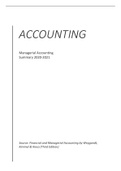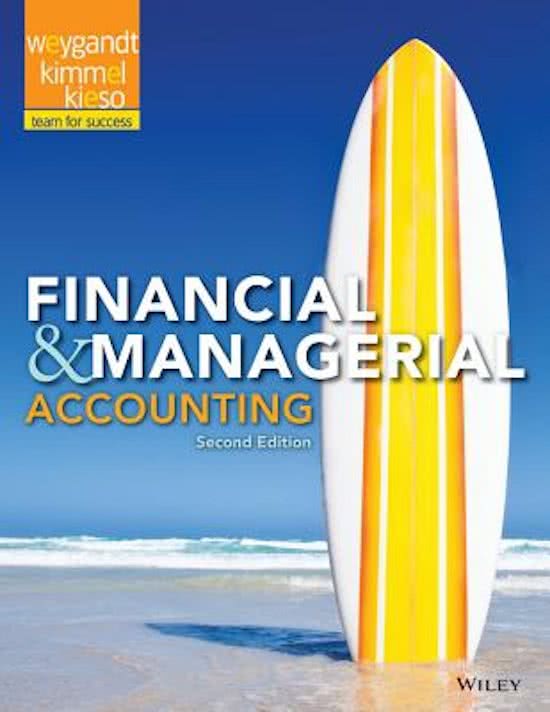ACCOUNTING
Managerial Accounting
Summary 2020-2021
Source: Financial and Managerial Accounting by Weygandt,
Kimmel & Kieso (Third Edition)
,Accounting part 2: managerial accounting
Chapter 14: introduction to managerial accounting
Managerial accounting is commonly seen as the accounting that the firm can present to
internal actors within the firm (managers, directors).
Inside the firm, which questions would you ask? What information would you need to know?
Some examples:
- Is the marketing department performing well?
- What is the cost of producing a new product?
- What should be the budget for next year?
- Is the recently opened store profitable?
- How big should the new production plan be?
Managerial accounting refers to the communication of economic and financial information
to managers and other internal actors. It is helpful for planning, directing and controlling.
Planning -> Managers can use managerial accounting to set goals for maximizing long-term
profit, increasing their market share and commit to environmental protection programs
Directing -> coordinate how sales and production divisions collaborate, provide incentives to
motivate employees, hire new managers.
Controlling -> track the performance of some divisions, determine whether key goals are
being met, implement systems to evaluate teams
FINANCIAL MANEGERIAL
PRIMARY USERS External Internal
FREQUENCY Quarterly, yearly As needed
PURPOSE General Specific
CONTENT Business as a whole Business units
Aggregated Detailed
GAAP Standards considered useful
VERIFICATION Audited No independent audits
Manufacturing consists of activities and processes that convert raw materials into finished
goods. Manufacturing costs incurred to produce a product are classified as direct materials,
direct labor, and manufacturing overhead. Direct materials: raw materials than can be
physically and directly associated with the finished product during the manufacturing
process are direct materials. Direct labor: work of employees than can be directly associated
with converting raw materials into finished goods. Manufacturing overhead: consist of costs
that are indirectly associated with the manufacture of the finished product. It includes
indirect materials, indirect labor, depreciation, insurance, taxes and maintenance on factory
facilities.
1
, Chapter 15: costs and job order costing
One of the key objectives of managerial accounting is to estimate costs. Why important?
Profit = revenue – cost. Costs are an element that companies might be able to control.
The two major types of companies: merchandisers and manufacturers. They both sell, so
they both have inventories and costs of goods sold.
For manufacturers, all costs can be split between manufacturing and nonmanufacturing
costs.
direct
indirect
A selling expense could be the payroll of a sales force: a team of people who promote sales
by phone, social media and other channels.
It is important to learn how to
classify costs!
Remember inventories? Let’s look at COGS again, but in more detail.
2
, Don’t confuse COGS with COGM!
Period costs are not included in COGS. It is included as selling or administrative expenses.
What about merchandisers? They also have inventories. COGP (cost of goods purchased) but
not COGM (no WIP inventories, raw materials). Same logic.
What about service industries, such as legal advice? No inventories. But they do have direct
and indirect costs, etc. Based on those costs, we can apply the same logic.
There are various methods to estimate costs: costing systems.
Two basic types: process costing and job order costing.
Process costing is appropriate when there are large volumes of production and the
production is continuous. Mainly time period costs.
Job order costing is appropriate when companies produce units and the production can be
divided in jobs or batches. Completed job costs.
We will only cover job order costing in this course.
3






